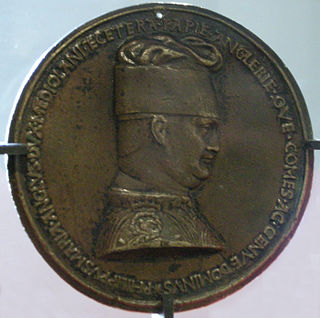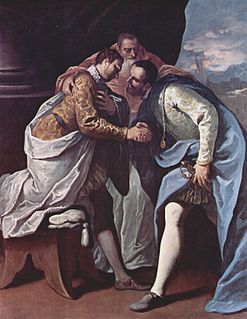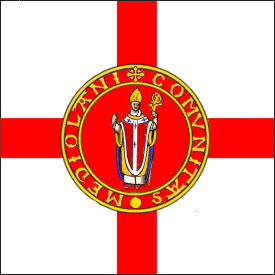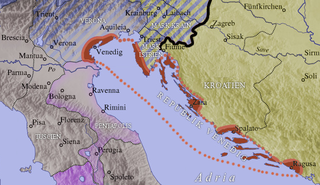The Peace of Cremona was concluded on 20 November 1441 between the Republic of Venice and the Duchy of Milan, ending the long conflict between the two powers over mastery in northern Italy.

The Republic of Venice or Venetian Republic, traditionally known as La Serenissima, was a sovereign state and maritime republic in what is now northeastern Italy, which existed for over a millennium between the 7th century and the 18th century from 697 AD until 1797 AD. It was based in the lagoon communities of the historically prosperous city of Venice, and was a leading European economic and trading power during the Middle Ages and the Renaissance. Citizens spoke primarily the still-surviving Venetian language, although publishing in (Florentine) Italian language became the norm during the Renaissance and after.

The Duchy of Milan was a state of the Holy Roman Empire in northern Italy. It was created in 1395, when it included twenty-six towns and the wide rural area of the middle Padan Plain east of the hills of Montferrat. During much of its existence, it was wedged between Savoy to the west, Venice to the east, the Swiss Confederacy to the north, and separated from the Mediterranean by Genoa to the south. The Duchy eventually fell to Habsburg Austria with the Treaty of Baden (1714), concluding the War of the Spanish Succession. The Duchy remained an Austrian possession until 1796, when a French army under Napoleon Bonaparte conquered it, and it ceased to exist a year later as a result of the Treaty of Campo Formio, when Austria ceded it to the new Cisalpine Republic.
The Wars in Lombardy were a series of conflicts between the Republic of Venice and the Duchy of Milan and their respective allies, fought in four campaigns in a struggle for hegemony in Northern Italy that ravaged the economy of Lombardy and weakened the power of Venice. They lasted from 1423 until the signing of the Treaty of Lodi in 1454. During their course, the political structure of Italy was transformed: out of a competitive congeries of communes and city-states emerged the five major Italian territorial powers that would make up the map of Italy for the remainder of the 15th century and the beginning of the Italian Wars at the turn of the 16th century. They were Venice, Milan, Florence, the Papal States and Naples. Important cultural centers of Tuscany and Northern Italy—Siena, Pisa, Urbino, Mantua, Ferrara—became politically marginalized.
Through the mediation of Francesco Sforza, an armistice was concluded on 6 August, and negotiations began in late September at the field of Cavriana near Cremona, chosen as neutral ground. [1] Sforza secured for himself the lordship of Cremona and the hand of Bianca Maria Visconti, the daughter of the Duke of Milan, Filippo Maria Visconti [1] —and thus, since the Duke had no other heir, his own ultimate succession to the ducal throne. [2]

Cremona is a city and comune in northern Italy, situated in Lombardy, on the left bank of the Po River in the middle of the Pianura Padana. It is the capital of the province of Cremona and the seat of the local city and province governments. The city of Cremona is especially noted for its musical history and traditions, including some of the earliest and most renowned luthiers, such as Giuseppe Guarneri, Antonio Stradivari, Francesco Rugeri, Vincenzo Rugeri, and several members of the Amati family.

Bianca Maria Visconti was Duchess of Milan from 1450 to 1468.

Filippo Maria Visconti was the duke of Milan from 1412 to 1447.
By the terms of the treaty, Venice was able to keep the Adda River as the boundary between its mainland possessions and the Duchy of Milan. [1] Venice also gained Riva di Lago from Milan, [1] as well as Lonato, Valeggio sul Mincio, Asola, and Peschiera del Garda from the Marquis of Mantua, who also handed over the Venetian cities he had captured during the course of the war. [1] Venetian possession of Ravenna was also recognized. [3] Milan also returned Imola and Bologna to the Papal States, and restored independence to the Republic of Genoa. [1]

The Domini di Terraferma was the name given to the hinterland territories of the Republic of Venice beyond the Adriatic coast in Northeast Italy. They were one of the three subdivisions of the Republic's possessions, the other two being the original Dogado ("Duchy") and the Stato da Màr overseas territories.

Valeggio sul Mincio is a comune (municipality) in the Province of Verona in the Italian region Veneto, located about 120 kilometres (75 mi) west of Venice and about 25 kilometres (16 mi) southwest of Verona. It is crossed by the Mincio river.

Asola is a comune in the province of Mantua, Lombardy. It received the honorary title of city with a presidential decree of October 23, 1951.









